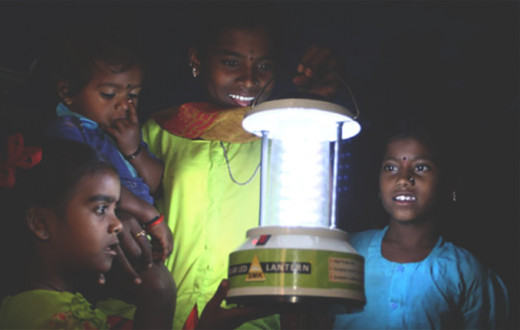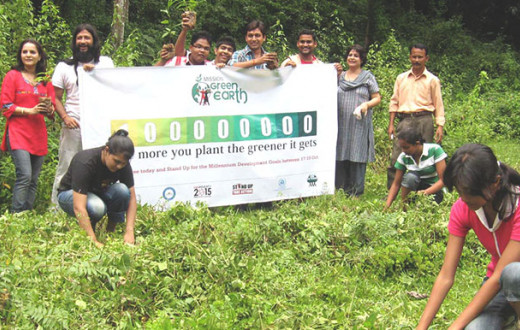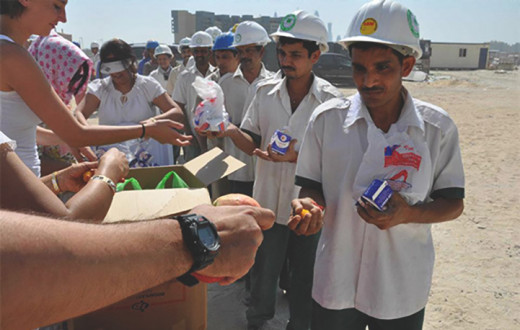Text by M Rajaque Rahman; Photo by Namita Malik
In a society where schools are benchmarked by the number of swimming pools and air-conditioned rooms they have, these schools may not even qualify as one. Put them in the context of the place they are located and then they are the only rays of hope for the next generation. This is the story of each of the 41 free schools run by the Art of Living in the remotest areas of the North Eastern Indian state of Tripura. These schools are not just providing free education to poor children, but acting as rallying points for far-reaching social transformations in the areas they are located. These schools provide holistic education and focus on inculcating human values, since this is the only way to long-term development. The schools are keen to make education accessible to first generation learners – as a means to bring a sea change in community.
“This school has brought about a drastic change in the children of this area. Not only their talents have blossomed, but also growing up very well mannered. We can’t compare this school with the government-run schools in any way.” This comment of Amar Singh Jamatia, a local leader of West Kuphilong in South Tripura where one of the schools is located, echoes the feelings of the locals who are benefiting from these schools. The 41 schools provide education to 1,855 children across the state. All amenities including uniforms, book, bags and mid-day meals are provided completely free. The donation from sponsors, for the cause of rural education, is key to the transformation happening in rural Tripura.
Education at Gunpoint
These schools are located in remotest places of Tripura. “Most of these villages of Tripura have remained backward as they were in the grip of insurgency from 2000 to 2008. Nobody dared to venture into these areas as there were instances of kidnapping and killing,” explains Swapan Patari, an Art of Living volunteer, who oversees the functioning of these schools across the state. Even the Art of Living volunteers had to risk their own lives. Debabrata Banik, who co-ordinates the school project in Tripura, recalls an intimidating incident he faced, when he was working to open a school in Malsoompara under Udaipur Division of South Tripura. “I was told to take ‘permission’ from a ‘powerful person of the village’ to start the school. When I went to meet him, he was sitting with an AK47 rifle by his side. That’s when I realized he was a leader of TNLF (Tribal National Liberation Front), which was engaged in an armed movement in the area. While his initial posture really scared me, he gave the ‘permission’, saying they would not harm anybody whose intention was to do good for the village.”
Teaching them to dream
More than the gun, it was the lack of awareness among the parents that the Art of Living had to fight to get the schools started. The schools are located in areas dominated by landless and illiterate laborers. Hence, education of the child is not a priority for the parents. There are many children who do not attend school at all. Many are forced to work in the field or take care of their younger siblings when the parents go to the field. Moreover, the state of affairs in the government-run schools is a big turn-off for the parents. “Teachers don’t come to the government school. The children go there only for the food served at the mid-day meal. So we felt no use in sending our children there,” says Manoj Kanti Chiran, a landless laborer and father of two. “Now the school run by Art of Living is providing real education to our children, and we can hope for a bright future for them,” he adds patting his son who studies in Class I in Sri Sri Seva Mandir at Gularibari, West Tripura. This school has given him so much confidence in education, that today he dreams of making his son a doctor. “ There is no harm in at least dreaming,” he murmurs shyly.
In the backdrop of this, convincing the parents to send their children to school hasn’t been an easy task. “Initially, we went house-to-house to convince the parents. They saw no point in sending their children to the government-run high school, which has only six teachers for a total of 14 classes,” explains Budhha Kumar, a 30-year-old yuvacharya (youth leader) of the Art of Living who oversees the day-to-day running of the school at Gularibari.
Winning the Hearts
“Our biggest advantage was that the parents listen to us because of the work we have done in the area other than the school, such as medical camps, health and hygiene campaigns,” explains Shamcharan Debverma, another yuvacharya from Gularibari. The people of the area have so much faith in him that they are encouraging him to contest the local body elections.
“Our Nav Chetna Shvirs (stress-relief camps), which were conducted for the villagers before opening the schools, played a major role in changing the mindset. These camps made them realize that education can change their lot. Thanks to this new-found awareness among the parents, we have more than 80 per cent attendance and almost zero dropout in all our schools,” says Debabrata Banik. “In many places, we started the school based on demands from the parents,” he adds. “The parents really respect us as teachers, and that shows that they now value the education of their children,” adds Uttam Debnath, who teaches in the West Kuphilong (South Tripura) school. In Gourangatilla, West Tripura, parents have become so motivated to educate their children that they have engaged a vehicle to transport their children to the school, spending Rs 200 per month. In some schools, one can see 60-year-olds coming from far-off villages to pick up their grandchildren.
Equal Partners
Interestingly, it’s the womenfolk who are leading this silent knowledge revolution. In many schools, one could see lines of women waiting for the school to close and take their wards home. In some cases, they sit through the whole day just to make sure the children stay in school.
But the men are not far behind. They are contributing at a different level to make sure that the new generation gets good education. In some places, they are making land available, at others they are constructing school buildings themselves, and in some others they are sponsoring teachers’ training. In Gourangatilla, the local club has donated the entire land earlier earmarked for it to Sri Sri Seva Mandir. And in Ishanpur (West Tripura), the school is run in the local club building. “This building was constructed for the local club, but the club was of not much use. So we have offered it to the Art of Living to run a school. And today, the school is making a big difference and helping the growth of the locality,” shares Nirmal Das, secretary of New Star Club. In Shantinagar under Khowai Division of West Tripura, the new school building was constructed with local support.
How do these uneducated parents get the vision that education can change the face of their village and get motivated to even part with their own houses? “In the absence of a school, the children of the village were getting into all kinds of vices at an early age. So I donated my own house to get the school started,” reveals Sunai Bhaktamal Malsoom of Malsoompara village. “Hardly anybody in the village is educated and hence education was not a priority for the villagers. The government-run school is closed for lack of teachers and students,” he says as if he was helping to crack the conundrum.
“After doing Youth Leadership Training Program (YLTP) of the Art of Living, I met Guruji (Gurudev Sri Sri Ravi Shankar) when he came to Arunachal Pradesh in 2008. While addressing a meeting of rural youth that I attended, Gurudev encouraged us to focus on starting free schools in our areas. Inspired by him, I decided to start a school in my village. The biggest problem was finding a suitable building. Finally, I decided to donate my own house. Initially we had very few children, but now we have more than 75 children,” he adds.
A Class Apart
Every parent is satisfied about the quality of education the Art of Living schools are ushering in the countryside of Tripura. “We don’t have the facilities we hear about towns, but the standard of education in this school is so good that we feel we live in a developed town,” says Sapna Deb of Shantinagar. This lady has a deep emotional attachment with the school. She was childless for eight years after marriage. Today her daughter is four years old and attending The Art of Living school.
Having an emotional bond or not, everybody swears by these schools. From one village to another, from one school to another, you can always spot a unique transformation. “The children who attend the Art of Living school learn to speak English. In the government school, the subjects are taught in vernacular only,” says Sataranjan Debverma whose daughter studies in Nursery in the Gularibari school. “The students of this school are different. Unlike the students of the government school, they study at home also, as learning has been made interesting by the teachers,” quips Sanjiv Das whose son studies in Class II in the Art of Living school located in Bagabasa, West Tripura.
“The Art of Living has brought quality education to this area,” says Kajalrani Debverma, Panchayat Member of Shantinagar. “Thanks to this school all the families of the village have access to quality education and that too in English medium, which was out of question for the villagers. The overall development of the children is amazing,” concurs Rabindra Dutta, Pradhan of the local Panchayat.
“Here even Class I children can sing the National Anthem whereas the Class VI students of government schools can’t,” says Amar Singh of West Kuphilong. “The Art of Living school here is doing so well that the government school is becoming almost empty. Hence to save their positions, teachers are indulging in misinformation and trying to discourage the parents from sending their children to this school,” he adds. On the flipside, many government-run schools are improving thanks to the competition.“Many Anganwadi centres in our areas have become active again thanks to the competition,” reports Samir Mazumdar, a local leader from Kalshi in South Tripura.
The Holistic Lesson
More than just good education, what is moving people’s hearts is the overall growth of the children who attend the Art of Living schools. “Here apart from good education, overall development of the child is attended to. Art, yoga and meditation are also taught. The biggest improvement is seen in their manners and discipline. This is remarkable because these children don’t have a conducive atmosphere at home,” opines Sudangshu Das, a graduate who has been teaching for last four years in the Gourangatilla school. He cites this far-reaching transformation as the reason for his working in the school, despite having to work longer hours for lesser salary. He isn’t alone to be inspired to walk the extra mile for a brighter future of Rural Tripura.
In some schools, teachers come from far off places. Pranab Mandy, who teaches in the Malsoompara school, cycles 20 km every day. “The children here are getting a lot more exposure in a stress-free environment,” adds Sudangshu. And that exposure is visible. “I retired after 35 years of teaching in government schools. But I couldn’t bring about the kind of transformation children here are witnessing. The level of education is much higher and the method is different. Here children are learning to take responsibility for themselves,” observes Sushil Chandra Deb, who is in-charge of the Gourangatilla school.
Extracurricular Payoffs
There is also an economic upside to this story of grassroots revolution unfolding in Tripura. These schools are not only providing free education, but also translating into big-time savings for the parents. “If we want to send our children to a good school, we will need to spend at least Rs 50 a day in transport. This school is helping us save that money,” calculates Jayanta Mazumdar, a small-time insurance agent whose daughter is studying in the school in Kalshi. There is no over-budgeting in this, for most of the Art of Living schools are located in places, where the nearest private school is at quite a distance.
These schools also promote the mingling of various communities. Most of the schools have mix of students from tribal communities, Bengalis and Bengali Muslims. “Earlier these communities lived in segregation. This school is doing a great job of uniting the different communities. Look at them. You will find people from all communities,” says Subrata Acharya, a committee member of the school at Garjee in South Tripura, pointing to the line of ladies who have come to collect their children. A few burqa-clad women were also among them as a testimony to his claim.
Health and hygiene is another area where these schools are revolutionizing Rural Tripura. Routine medical check-ups are held to ensure health of not only the children but also the parents. “We have benefited a lot from the medical camps,” testifies Bithi Rai, whose daughter studies in the Garjee school. In Kalshi, the school organised Hepatitis vaccination for all the children, their parents and other villagers. “This school is acting as a rallying point for health and hygiene in the area. Thanks to the exposure, the villagers are becoming more receptive of our health and hygiene campaigns in the area,” reasons Nandalal Bhowmik, a Yuvacharya working in the area.
Out of School
Not only children but also elders are getting empowered. “After doing the Art of Living, I felt so confident of my abilities that I am able to teach in the village school now. Although I studied up to secondary level from the government school, I was not confident to do anything on my own. But, now I am teaching in the school,” testifies Reshma Debverma, a teacher in the Gularibari school. Shanti Rai of Malsoompara is another. She got opportunity to study up to Class IX only. “I was determined to make sure that the children of my village don’t suffer because of lack of opportunities. So when the Art of Living opened the school, I decided to teach in this school.”
These ladies are achievers since they have broken the social barriers, and have come this far in a society where education had no place until recently. They live in a society deeply steeped in traditional beliefs that place a lot of obstacles.
Truly, education can change lives.







